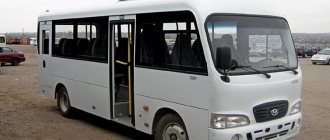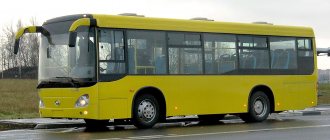LAZ 695, also known as “Lvov”, is a Soviet and then Ukrainian vehicle that was produced at the Lvov bus plant. It can be safely entered into the Book of Records of Ukraine. The machine was regularly modernized and (attention!) remained on the assembly line for 46 years. This is a unique record of its kind, when the same bus model was produced at a single plant. The production of Soviet LAZ vehicles started immediately after the war, in 1945. Initially, they wanted to produce ZIS model 155 here, but the young team decided to take the initiative. Engineer Osepchugov infected his colleagues with the “bus disease.” The entire LAZ model range.
Story
In 1949, the plant began producing car vans, trailers, truck cranes and (pilot batch) electric vehicles. With the development of automobile production, a design team was formed under the leadership of V.V. Osepchugov. At first, they planned to transfer the production of obsolete ZIS-155 buses from the Moscow Stalin Plant to the plant, but such a prospect did not inspire the young staff of the plant and its design bureau. With the support of the first director of LAZ, B.P. Kashkadamov, Osepchugov literally infected young designers and production workers who had just left the institute classrooms with the “bus dream.”
City bus LAZ-695. Photo Wikipedia
The initiative to develop and produce a new model was supported “at the top” and samples of modern European buses were purchased for LAZ designers in order to study current trends in automotive design and technology: Magirus, Neoplan, Mercedes. When designing the structure, the experience of the Mercedes Benz 321 was taken into account, and it was decided to make external stylistic decisions in the spirit of Magirus; Moreover, the model was developed by the plant independently and was original. After studying advanced designs and production technology, LAZ moved on to creating its first-born bus, which was almost completed by the end of 1955.
Construction of the first LAZ-695 began in 1955.
New life
I can’t help but note that the owner of the “festival” gets a lot of positive emotions from the creative process of working on the bus and driving it. In many ways, learning about a new design and working on a car in a pleasant company is an interesting experience even for a person who has owned many different cars. Each new step in the bus world becomes a kind of achievement, and while there are no “D” licenses, rare trips in the pilot’s seat - even on closed areas - bring him real boyish joy.
Among other things, the bus not only pleases the owner’s eye, but also periodically works for its intended purpose. Of course, he no longer transports factory workers: now LAZ serves various orders, primarily weddings and holidays, acts in films and often appears at various events related to retro technology. For example, in the summer it was used to travel to Tula on the Autostrada, and in September it became an exhibit at the Automotive Industry exhibition in the Space pavilion on the territory of the revived VDNKh. The latter became a real recognition for the bus and its owner: it is on a par with exhibits from the best collections of the country, and therefore corresponds to the level they set.
Description
The bus has undergone modernization more than once, mainly with changes in the appearance of the body , but the overall size and layout of the body and the main units remained the same. The most significant change relative to the basic first generation 695/695B/695E/695Zh was the modernization of the front and rear parts in two stages - first, in the second generation 695M, the rear part was changed (with the replacement of one large “turbine” air intake at the rear of the roof with two side “gills” ) with an almost unchanged front mask, and then the third generation 695N/695NG/695D also received a modernized front part (the “slicked-back” shape was replaced by a “visor”). In addition, the factory emblems and the space between the headlights on the front end changed (both from generation to generation and within generations; for example, in the third - from an aluminum false radiator grille to the same black-plastic one and then its complete removal), headlights and sidelights, front bumpers, wheel covers, etc.
Bus LAZ-695N. Photo Wikipedia
There is reason to believe that a small batch of buses with an automatic transmission (LAZ-695E) was produced.
Not without a number of shortcomings (crowded interior and doors, frequent overheating of the engine of buses of the 2nd and 3rd generations, etc.), the bus was characterized by simplicity of design and unpretentious operation on all categories of roads. In the post-Soviet space, both 21st-century and 30-year-old LAZ-695 buses are still used. In Belarus, the latest LAZ-695 models were withdrawn from service in July 2007. Even without taking into account custom assembly in small-scale batches at DAZ, mass production at LAZ continued for 45 years. The total number of LAZ-695 buses produced is about 250 thousand vehicles (only 695M - more than 52 thousand and 695N - about 176 thousand vehicles).
Modifications: 695B; 695N and others
In the spring of 1956, LAZ manufactured the first prototypes of the LAZ-695 , and a pilot series was built in 1957.
The layout with the ZIL-124 engine located in the rear overhang was used for the first time in the USSR. The all-welded body of the LAZ-695 also had a progressive design . All loads were carried by a load-bearing base, which was a spatial truss made of thin-walled steel pipes of rectangular cross-section. The body frame is rigidly connected to this base. The outer cladding was made of duralumin sheets , which were attached to the body frame with “electric rivets” (spot welding).
The first prototype of the LAZ-695 bus. Photo Wikipedia
The double-disc clutch and five-speed gearbox were borrowed from the ZIL-158 bus. An interesting innovation was the dependent spring-spring wheel suspension, developed jointly with NAMI specialists. Additionally, correction springs provided the overall suspension with a nonlinear characteristic - its rigidity increased with increasing load, resulting in comfortable conditions for passengers regardless of the load. This circumstance has won a high reputation for LAZ vehicles.
But as a city bus, the LAZ-695 was imperfect : there was no storage area at the front door, the passage between the seats and the doors were not wide enough. The engine compartment in the cabin took up a lot of space. The bus could most successfully be used for suburban transport, tourist and intercity trips. Therefore, 2 more models were immediately included in the unified series: the tourist LAZ-697 and the intercity LAZ-699.
Despite certain shortcomings, the LAZ-695 stood out among other domestic buses. Thin body window pillars with sliding windows and curved glass built into the radius roof slopes gave a light, “airy” look. Large radii of curvature on the edges and corners of the body created the visual effect of a streamlined car.
If we compare the LAZ-695 with the popular city bus of that time, the ZIS-155, the first one could accommodate 5 more passengers, was 1040 mm longer, but 90 kg lighter and had the same top speed - 65 km/h.
LAZ-695 had an interesting design feature . If necessary, the bus could easily be converted into an ambulance. To do this, it was enough just to dismantle the seats in the cabin. In the front part, under the windshield to the right of the driver's seat, an additional door was provided in the body for loading the wounded. Such an innovation was quite justified at the time when this bus was created.
LAZ-695B (1958-1964). At the end of 1957, the LAZ-695 was modernized for the first time : the base of the body was strengthened, and a pneumatic door opening drive was introduced instead of a mechanical one. Moreover, since 1958, instead of side air intakes, a wide “turbine” bell was used at the rear of the roof. Through it, air containing noticeably less dust entered the engine compartment. Also thanks to him, the inside of the rear part of the cabin became more beautiful , since the engine compartment was camouflaged.
have also undergone changes, the way of installing passenger seats, the tilt of the driver's steering column and much, much more have changed. The door control valve on the left side of the instrument panel was moved to the driver's seat on the left side, as on the ZIS-155 and ZIL-158. The driver's cabin partition was low (not up to the ceiling) and had no passage into the cabin. On later cars the partition was raised to the ceiling , and a passage into the cabin appeared. Sliding window vents have become wider.
Bus LAZ-695B. Photo Wikipedia
The LAZ-695B of early production had a double-disc clutch and a gearbox with a direct fourth gear and an accelerating fifth . Later they began to install a single-disc clutch and a gearbox with direct fifth gear for the same six-cylinder in-line engine.
At first, the serial LAZ-695B retained a very large glass area on the roof slopes, but the operators constantly complained to the factory about the weakness of the entire upper part of the body. As a result, the glazed front corners of the roof slopes first disappeared (autumn 1958), and later the glazing of the rear slopes was significantly reduced . It is interesting that, as an experiment, in 1959, a copy of the LAZ-695B was made without any glazing on the roof slopes , but, apparently, such a radical approach to increasing the rigidity of the roof then seemed excessive, and the glazing on the slopes was left on production vehicles, only reducing it slightly.
Later, by the autumn of 1959, the front roof design of the LAZ-695B buses was slightly changed, as a result of which the first small “cap” visor appeared above the windshield. Thanks to this, the appearance has noticeably improved.
The modernized LAZ-695B buses began to be mass-produced in May 1958 (by the end of 1958, 1000 LAZ-695B units were built), in 1960 the plant completely switched to the production of LAZ-695B. In total, by 1964, 16,718 complete first-generation LAZ-695B buses were produced, also on its basis 10 completely complete LAZ-695T trolleybuses and 551 bodies for trolleybuses from the OdAZ and KZET factories.
One of the LAZ-695 produced in 1959 was made with an experimental rubber-pneumatic suspension (developed by specialists from NAMI and the Research Institute of the Tire Industry and installed instead of standard springs), another LAZ-695, instead of the standard metal cladding made of steel and aluminum sheets, was made with plastic cladding (which reduced the weight by 300 kg).
Based on the LAZ-695B bus, the LAZ-697 “Tourist” was produced with a six-cylinder in-line ZIL-158L engine.
LAZ-695E (1963-1970). After ZIL began production of the ZIL-130 V-shaped eight-cylinder engine, the question arose about equipping LAZ buses with them. In 1961, the first prototypes of the LAZ-695E with a ZIL-130Ya engine with a power of 150 hp were manufactured. with., improved braking system and new gearbox.
Bus LAZ-695E. Photo Wikipedia
Serial production of the LAZ-695E began in 1963 , 394 copies were produced in 1963, but from April 1964 the plant completely switched to the production of the “E” model. In total, until January 1970, 37,916 LAZ-695E buses were produced, including 1,346 for export.
The LAZ-695E buses produced in 1963 were no different in appearance from the LAZ-695B produced at the same time (except for the fact that another exhaust pipe appeared), but since 1964 all LAZ buses received new rounded wheel arches , according to with which the LAZ-695E became recognizable externally. LAZ-695E, unlike LAZ-695B, was equipped with front and rear axle hubs, as well as wheel rims the same as those used on the ZIL-158. Since 1969, an electro-pneumatic door control drive has been introduced.
In this regard, the door control valve was canceled, and two switches (toggle switches) appeared on the instrument panel, and later - two door control keys. From the same year, they began installing Hungarian-made Raba rear axles. The instrument panel on the LAZ-695E was changed: an instrument cluster and a different speedometer appeared. On the LAZ-695B and LAZ-695E vehicles there were no upper rear marker lights. Based on the LAZ-695E bus, the LAZ-697E “Tourist” was produced.
Due to the fact that large dies were used to manufacture the main parts of the LAZ-695 body, the production and debugging of which required time and large financial costs, it was decided to carry out the next stage of modernization in two stages: at the first stage it was necessary to change the rear part of the body, the roof and upgrade the units, and at the second stage - replace the front part of the body. The design of the new model was entrusted to the GSKB for buses.
LAZ-695Zh (1963-1965). In those same years, together with the NAMI automatic transmission laboratory, the plant began developing a hydromechanical transmission for a city bus.
In 1963, the first industrial batch of buses with such a transmission was assembled at LAZ. They received the name LAZ-695Zh. However, for two years from 1963 to 1965. Only 40 LAZ-695Zh buses were assembled, after which their production was discontinued. The fact is that buses of the LAZ-695 type were mainly used on suburban lines, and they were not suitable for busy city routes, so they were specially designed for large cities in the mid-1960s. created the LiAZ-677 bus, for which all sets of hydromechanical transmissions produced at LAZ were transferred.
LAZ-695Zh were no different in appearance from similar buses with a manual transmission of the same manufacturing period.
LAZ-695M (1969-1976). The first prototype entered testing in 1967. A set of innovations implemented in 1969 made it possible to significantly improve the appearance of the base model, which became known as the LAZ-695M.
Bus LAZ-695M on a pedestal on the territory of a bus depot in Kazan. Photo Wikipedia
The roof became flat (with corresponding changes in the design of the body frame and the removal of glazing on the roof slopes), higher side window glass was installed, and changes were made to the interior trim. The bus also received a new unified rear axle “Rába” with planetary gearboxes in the wheel hubs and an improved braking system with separate drive of the front and rear brakes, a modified instrument panel, new side turn indicators and new side lights, improved sound insulation of the engine compartment from the passenger compartment, aluminum floors , steps and door leaves. The “turbine” central air intake at the rear was replaced - first with narrow slits in the rear of the body above the hood, and later with small “gills” slits on the sidewalls.
In 1969, serial production of the LAZ-695M began; in 1970, the plant completely switched to production of the LAZ-695M.
In 1973, wheels of a modified design : with conical shelves and windows of a different configuration. The windows in the disks became not five, but four.
In 1974, the bus received one common muffler instead of the two separate ones used previously. The car has become 100 mm shorter, and its curb weight is greater. In addition, the shape of the last side windows and the engine air intake were changed; they were unified with the future LAZ-695N model.
Production of the second generation LAZ-695M lasted seven years and during this time 52,077 copies were produced, including 164 for export. Based on the LAZ-695M bus, the LAZ-697M “Tourist” was produced.
LAZ-695N (1974—2010). Having received a new front body panel with higher windshields and a large visor on top, the car began to be called LAZ-695N. On this model, the rear and front doors became the same . The instrument cluster and speedometer have become slightly smaller in diameter. The first prototypes were demonstrated in 1969.
In 1974, the plant began serial production of the LAZ-695N. LAZ-695N cars from the late 70s - early 80s. had small windows on the outside above the doors to the salon with illuminated “Entrance” and “Exit” signs; on later cars they were removed. Also, later LAZ-695N buses differ from earlier vehicles in the shape and location of the front and rear lighting equipment. rectangular headlights made in the GDR, the same as those on the Moskvich-412 car, and an aluminum false radiator grille were installed in front Since the mid-80s. The aluminum grille was eliminated, and the headlights became round.
Bus LAZ-695N. Photo Wikipedia
In 1978, on the basis of the LAZ-695N, a special training bus for driver training, equipped with an additional control kit and a set of fixing equipment (speedometer SL-2M, tachograph 010/10, mode meter, three-component overload recorder ZP-15M and tape recorder).
, a small number of buses of the LAZ-695R modification were produced with more comfortable and soft seats and double doors (which were previously also on prototypes of the LAZ-695N, but were not put into production). After the Olympics, buses of this modification were used as excursion buses.
Until 1991, LAZ-695N buses were required to have a large opening hatch in the front wall of the body - in the event of military mobilization, they were converted into ambulances, and the hatch was intended for loading and unloading stretchers with the wounded (it would have been impossible to carry stretchers through the narrow doors). After 1991, this “extra detail” was quickly eliminated.
In the first half of the 1990s, power steering appeared . At the same time, they stopped installing the “Slave” rear axles and again, as many years ago, they began to equip the car with a double final drive (without wheel reduction gears).
Based on the LAZ-695N, the LAZ-697N "Tourist" (1975-1978) and LAZ-697R "Tourist" (1978-1985) buses were produced.
Buses of this modification are still found in the countries of the former USSR as commuter, service and educational buses.
LAZ-695NG (1985—2010). Modification of LAZ-695N, the first Soviet serial bus with a gaseous fuel power plant, using high-pressure compressed natural gas as fuel.
LAZ-692 (1986). To carry out work to eliminate the consequences of the accident at the Chernobyl nuclear power plant on May 22, 1986, the USSR Ministry of Automotive Industry developed a technical specification, according to which the Lvov Automobile Plant was instructed to build in June 1986 a batch of five special LAZ-692 buses equipped with protection from gamma radiation and radioactive dust.
Bus LAZ-695NG. Photo Wikipedia
LAZ-692 were produced on the basis of the mass model LAZ-695N, but they were equipped with lead sheets covering most of the windows, and air filtration systems were installed on the roof, which had no hatches. LAZ-692, along with the civilian LAZ-695N, was used to evacuate the local population and to deliver liquidators to the Chernobyl nuclear power plant. These buses were then scrapped because they had been exposed to heavy radioactive radiation and were unsuitable for further use.
LAZ-695D, LAZ-695D11 (1993—2002). In 1993, at LAZ, on an experimental basis, they tried to install Kharkov diesel engines D-6112 from the T-150 tractor and 494L from military equipment on the LAZ-695 bus. In the same 1993, the Dnipropetrovsk association “DniproLAZavtoservice” began to equip LAZ-695N buses with diesel engines from Kharkov SMD-2307.
But the efforts of the “International Automotive Trade Association of Ukraine” turned out to be the most effective. According to his order, LAZ developed and began mass-producing in 1995 a diesel modification - LAZ-695D, which received its own name “Dana”. This bus was equipped with a D-245.9 diesel engine from the Minsk Motor Plant. This modification was mass-produced at LAZ until 2002 and since 2003 it has been produced at the Dneprodzerzhinsk Dneprovsky Bus Plant (DAZ).
In 1996, the diesel bus project was significantly redesigned, resulting in the LAZ-695D11 “Tanya”. This project was coordinated by, part of the MAO. The Tanya bus differed from the previous diesel model by hinged doors in the front and rear overhangs and soft seats installed in the cabin. By and large, this was a return to the long-discontinued medium-sized intercity bus LAZ-697 in a new quality and under a new name. The LAZ-695D11 “Tanya” modification was produced serially in small batches.
LAZ-695 in 2002-2010 In May 2002, the press service of the Lviv Automobile Plant announced the cessation of production of all modifications of the LAZ-695, and in June 2002, the production of all modifications of the LAZ-695 in Lvov was discontinued.
But the production of LAZ-695N buses did not stop. All technological documentation and equipment were transferred to DAZ, where small-scale assembly of LAZ-695N buses continued until 2010. Dneprodzerzhinsk LAZ-695N buses differ from Lviv ones in the absence of a driver's door, seamless sides without molding and yellow handrails in the interior.
In the next episodes
After the fall of the Union, LAZ began to lose its title as the flagship of the post-Soviet bus industry.
Despite the fact that after the classic family, many new models managed to enter the series, the rapid decline in demand for large buses, on the one hand, and economic isolation and loss of large markets, on the other, could not but make themselves felt. At the end of the nineties, the annual production of buses moved from thousands to hundreds, in the new century - to dozens, and in recent years it has been exclusively sporadic. Since 2006, LAZ has been in a state of sluggish bankruptcy and fought with creditors in legal disputes. In recent years, the plant has carried out rare and small orders - primarily for trolleybuses with bodies that were prepared with the expectation of large tenders from cities participating in Euro 2008 (welding of new bodies stopped back in 2011). Now, when the country’s economy is feeling especially bad, the plant has stopped even applying for tenders and is slowly dying, losing its staff and its last vitality.
The plant in Dneprodzerzhinsk, where production of the old family was transferred, produced LAZ-695 in fairly limited quantities. By 2008, the production of new bodies was stopped, and the remaining ones began to be sold only as repair ones to “replace” old ones (in fact, the bus turned out to be new). Such cars appeared until 2011, where the history of the illustrious family ended.
Basic characteristics
- Body dimensions, mm. (LxWxH). 9290x2500x2980.
- Number and dimensions of doors. Three: two passenger 4-leaf doors and a driver's door. Opening width – 830 mm.
- Total number of seats, including landing seats. 67, including 33 landing ones.
- Type of seats. The seats are arranged in 4 rows, the last 5 seats are combined into one sofa, consisting of 3 sections (two 2-seater and one single). Cars of various years of manufacture also have 1 service seat near the rear door. The driver's seat is movable in 3 directions.
LAZ-695B (1958—1964)
At the end of 1957, the LAZ-695 was modernized for the first time: the base of the body was strengthened, and a pneumatic door opening drive was introduced instead of a mechanical one. Moreover, since 1958, instead of side air intakes, a wide “turbine” bell was used at the rear of the roof. Through it, air containing noticeably less dust entered the engine compartment. Also thanks to him, the rear of the cabin became more beautiful inside, since the engine compartment was camouflaged. The headlight design of the front end, the brake system, the heating of the bus have also undergone changes, the method of installing passenger seats, the tilt of the driver's steering column and much, much more have changed. The door control valve on the left side of the instrument panel was moved to the driver's seat on the left side, as on the ZIS-155 and ZIL-158. The driver's cabin partition was low (not up to the ceiling) and had no passage into the cabin. On later cars the partition was raised to the ceiling, creating a passage into the cabin. Sliding window vents have become wider.
The LAZ-695B of early production had a double-disc clutch and a gearbox with a direct fourth gear and an accelerating fifth. Later they began to install a single-disc clutch and a gearbox with direct fifth gear for the same six-cylinder in-line engine.
At first, the serial LAZ-695B retained a very large glass area on the roof slopes, but operators constantly complained to the plant about the weakness of the entire upper part of the bus body. As a result, the glazed front corners of the roof slopes first disappeared from buses (autumn 1958), and later the glazing of the rear slopes was significantly reduced. It is interesting that, as an experiment, in 1959, a copy of the LAZ-695B bus was made without any glazing on the roof slopes, but, apparently, such a radical approach to increasing the rigidity of the roof then seemed excessive, and on production vehicles the glazing on the roof slopes was left, only slightly reducing it .
| External images | |
| LAZ-695B | |
| [www.avsim.ru/forum/uploads/monthly_01_2009/post-7264-1231525722_thumb.jpg] | |
| [www.bus2.ru/images/photo/img-866.jpg] | |
Later, by the fall of 1959, the design of the roof on the front of the LAZ-695B buses was slightly changed, as a result of which the first small “cap” visor appeared above the windshield of the bus. Thanks to this, the appearance of the bus has noticeably improved.
The modernized LAZ-695B buses began to be mass-produced in May 1958 (by the end of 1958, 1000 LAZ-695B units were built), in 1960 the plant completely switched to the production of LAZ-695B[3]. In total, by 1964, 16,718 complete first-generation LAZ-695B buses were produced, also on its basis 10 completely complete LAZ-695T trolleybuses and 551 bodies for trolleybuses from the OdAZ and KZET factories.
One of the LAZ-695 buses produced in 1959 was made with an experimental rubber-pneumatic suspension (developed by specialists from NAMI and the Research Institute of the Tire Industry and installed instead of standard springs)[5], another LAZ-695 instead of the standard metal casing made of steel and aluminum sheets was made with a plastic cladding (which reduced the weight of the bus by 300 kg)[6].
Based on the LAZ-695B bus, the LAZ-697 “Tourist” bus was produced with a six-cylinder in-line ZIL-158L engine.
Specifications
- Fuel type. Petrol.
- Fuel tank capacity, l. 154.
- Curb and technically permissible weight, kg. 6800 and 11200.
- Steering gear. With amplifier.
- Brake system. The brake system is of a dual-circuit type, has a pneumatic drive and a drum mechanism. The parking brake affects the rear wheel devices. Their drive is mechanical. The spare brake is one of the circuits of the working brake system. It is driven by an air compressor with a pair of cylinders. It has pistons and water cooling. It is also connected by flexible hoses to a pneumatic system. The pressure regulator contains ball-type valves. To accumulate air, 5 receivers with pressure sensors are installed. And on one of them there is even a crane for inflating the wheels. The brake drum contains two brake pads.
A little from the author
Any Soviet bus or truck differs from European vehicles in two important characteristics.
The first is equipment of increased reliability, since all of it is designed in case of war. The second logically follows from the first: all transport has standardized components and mechanisms, which increases its maintainability, facilitates maintenance, and simplifies the study of the machines themselves. In fact, and this has long been known, trucks and buses produced in the USSR are construction kits. Compared to the level of standardization in the USSR, European brands are still babies in this regard: the EU is only 20 years old and the path to total unification and common GOST standards is still ahead of them. If you accidentally wedge yourself into a conversation between two normal, knowledgeable drivers about certain machine components, you are unlikely to immediately understand which model we are talking about. For example, an engine from ZIL or MAZ can be installed on at least 5 different cars, this is at best. Mechanics who repair only KAMAZ or ZIL vehicles are quite capable of understanding mechanics of other Soviet brands. And this is not because mechanics are deeply interested in the structural differences of all machines, but because all the components of Soviet technology are simple and similar.
The same fate befell the LAZ-695 N. The car turned out to be simple and reliable. Its only radical difference, in my opinion, is the seats in the passenger compartment: I have never seen anything like this in any other bus of the Soviet automobile industry. Although the author may be wrong. Now about the technical characteristics of the LAZ 695, in more detail.
Engine/powertrain characteristics
- Model. ZIL-124.
- Type. Carburetor.
- Number and arrangement of cylinders. 6, in-line.
- Working volume, l. 5,5.
- Engine power, kW (hp)/min. 70 (95).
- Engine location. Rear.
- Checkpoint. ZIL, manual 5-speed.
- Front-rear axle suspension. Dependent spring with correction springs - Dependent spring with correction springs.
- Control fuel consumption at 60 km/h, l/100 km. 35-40.
- Maximum speed, km/h. 86.
The first LAZ-695 (1956—1958)
In the spring of 1956, LAZ produced the first prototypes of the LAZ-695 bus[2], and in 1957 a pilot series of buses was built[3].
The layout with the ZIL-124 engine located in the rear overhang of the bus was used for the first time in the USSR. The all-welded body of the LAZ-695 also had a progressive design. All loads were carried by a load-bearing base, which was a spatial truss made of thin-walled steel pipes of rectangular cross-section. The body frame is rigidly connected to this base[4]. The outer cladding of the bus was made of duralumin sheets, which were attached to the body frame with “electric rivets” (spot welding).
The double-disc clutch and five-speed gearbox were borrowed from the ZIL-158 bus. An interesting innovation was the dependent spring-spring suspension of the bus wheels, developed jointly with NAMI specialists. Additionally, correction springs provided the overall suspension with a nonlinear characteristic - its rigidity increased with increasing load, resulting in comfortable conditions for passengers regardless of the load. This circumstance has won a high reputation for LAZ vehicles.
But as a city bus, the LAZ-695 was imperfect: there was no storage area at the front door, the passage between the seats and the doors were insufficiently wide. The engine compartment in the cabin took up a lot of space. The bus could most successfully be used for suburban transport, tourist and intercity trips. Therefore, 2 more models were immediately included in the unified series: the tourist LAZ-697 and the intercity LAZ-699.
Despite certain shortcomings, the LAZ-695 stood out among other domestic buses. Thin body window pillars with sliding windows and curved glass built into the radius roof slopes gave the bus a light, “airy” look. Large radii of curvature on the edges and corners of the body created the visual effect of a streamlined car.
If we compare the LAZ-695 with the popular city bus of that time, the ZIS-155, the first one could accommodate 5 more passengers, was 1040 mm longer, but 90 kg lighter and had the same top speed - 65 km/h.
| External images | |
| LAZ-695 | |
| [www.perevozka.info/images/knowledge/00001334_o.jpg] | |
| [www.perevozka.info/images/knowledge/00001336_o.jpg] | |
LAZ-695 buses had an interesting design feature. If necessary, the bus could easily be converted into an ambulance. To do this, it was enough just to dismantle the seats in the cabin. In the front part of the bus, under the windshield to the right of the driver's seat, an additional door was provided in the body for loading the wounded. Such an innovation was quite justified at the time when this bus was created.
LAZ-695D, LAZ-695D11 (1993—2002)
In 1993, at LAZ, on an experimental basis, they tried to install Kharkov diesel engines D-6112 from the T-150 tractor and 494L from military equipment on the LAZ-695 bus. In the same 1993, the Dnipropetrovsk association “DniproLAZavtoservice” began to equip LAZ-695N buses with diesel engines from Kharkov SMD-2307.
But the efforts of the “International Automotive Trade Association of Ukraine” turned out to be the most effective. According to his order, LAZ developed and began mass-producing in 1995 a diesel modification of the bus - LAZ-695D, which received its proper name “Dana”. This bus was equipped with a D-245.9 diesel engine from the Minsk Motor Plant. This modification of the bus was mass-produced at LAZ until 2002 and since 2003 it has been produced at the Dneprodzerzhinsk Dneprovsky Bus Plant (DAZ).
In 1996, the diesel bus project was significantly redesigned, resulting in the LAZ-695D11 “Tanya” bus. This project was coordinated by, part of the MAO. The Tanya bus differed from the previous diesel model by hinged doors in the front and rear overhangs and soft seats installed in the cabin. By and large, this was a return to the long-discontinued medium-sized intercity bus LAZ-697 in a new quality and under a new name. The LAZ-695D11 “Tanya” modification was produced serially in small batches.
Notes
- A. L. Abramson, Ph.D. those. n. I. G. Barannik, A. A. Zdanovsky. Unification of electrical equipment of buses // magazine "Automotive Industry", No. 7, 1980. pp. 9-11
- A. I. Skerdzhev. New Soviet buses // magazine “Behind the Wheel”, No. 5, May 1956. pp. 5-7
- ↑ 12345
Brief biography of car factories. Years and facts // magazine “Behind the Wheel”, No. 12, December 1974. p. 20 - ↑ 12
K. M. Atoyan. Modernized LAZ buses // magazine “Behind the Wheel”, No. 1, January 1962. pp. 11-13 - B. Zubchuk. Seven-year buses // magazine “Behind the Wheel”, No. 2, February 1959. p. 14
- K. M. Atoyan. 5000 buses per year // magazine “Behind the Wheel”, No. 7, July 1959. p.3
- ↑ 12
K. Atoyan. LAZ is being improved // magazine “Behind the Wheel”, No. 12, December 1970. pp. 6-7 - A. Mukhamyatov. Training bus // Automobile Transport magazine, No. 7, 1978. p. 48
- G. V. Skrechko, S. G. Denis, S. L. Zolotarevsky. Towards the creation of the design of the LAZ-695NG bus running on natural gas // “Avtodorozhnik of Ukraine”, No. 3, 1984, pp. 17-20
- Resolution of the Central Committee of the CPSU and the Council of Ministers of the USSR No. 583 of May 22, 1986 “On measures to ensure the commissioning of power units of the Chernobyl nuclear power plant that are in reserve”
- [www.ussrtoscale.com/—-692.html LAZ-692 – USSR on Scale]
- [www.autoconsulting.com.ua/article.php?sid=465 In 2002, LAZ will produce more than 2,100 buses] // “AUTO-Consulting.UA” dated May 27, 2002
- Tatiana Korniychuk. LAZ stopped producing the 695th model // “Mirror of the Week” dated June 14, 2002
LAZ-695M (1969—1976)
The first prototype entered testing in 1967. A set of innovations implemented in 1969 made it possible to significantly improve the appearance of the base model, which became known as the LAZ-695M.
The roof of the bus became flat (with corresponding changes in the design of the body frame and the removal of glazing on the roof slopes), higher side window glass was installed, and changes were made to the interior trim. The bus also received a new unified rear axle “Rába” with planetary gearboxes in the wheel hubs and an improved braking system with separate drive of the front and rear brakes, a modified instrument panel, new side turn indicators and new side lights, improved sound insulation of the engine compartment from the passenger compartment, aluminum floors , steps and door leaves. The "turbine" central air intake at the rear was replaced - first with narrow slits in the rear of the body above the hood[7], and later with small slits - "gills" on the sidewalls.
In 1969, serial production of the LAZ-695M began; in 1970, the plant completely switched to the production of LAZ-695M[3].
In 1973, wheels of a modified design began to be installed on cars: with conical shelves and windows of a different configuration. The windows in the disks became not five, but four.
| External images | |
| LAZ-695M | |
| [avto-cccp.ru/wp-content/uploads/2013/02/LAZ-695M-Lviv-2.jpg] | |
| [avto-cccp.ru/wp-content/uploads/2013/02/LAZ-695M-Lviv-1.jpg] | |
In 1974, the bus received one common muffler instead of the two separate ones used previously. The car has become 100 mm shorter, and its curb weight is greater. In addition, the shape of the last side windows and the engine air intake were changed; they were unified with the future LAZ-695N model.
Production of the second generation LAZ-695M lasted seven years and during this time 52,077 copies were produced, including 164 for export. Based on the LAZ-695M bus, the LAZ-697M “Tourist” bus was produced.
LAZ-695E (1963—1970)
After ZIL began production of the ZIL-130 V-shaped eight-cylinder engine, the question arose about equipping LAZ buses with them. In 1961, the first prototypes of the LAZ-695E[3] bus with a ZIL-130Ya engine with a power of 150 hp were manufactured. p., improved braking system and new gearbox[4].
Serial production of the LAZ-695E began in 1963; 394 copies were produced in 1963, but from April 1964 the plant completely switched to producing the 'E' model. In total, until January 1970, 37,916 LAZ-695E buses were produced, including 1,346 for export.
The LAZ-695E buses produced in 1963 were no different in appearance from the LAZ-695B buses produced at the same time (except for the fact that another exhaust pipe appeared at the rear at the bottom right), but since 1964 all LAZ buses received new rounded ones wheel arches, by which the LAZ-695E began to be recognized externally. LAZ-695E, unlike LAZ-695B, was equipped with front and rear axle hubs, as well as wheel rims the same as those used on the ZIL-158. Since 1969, an electro-pneumatic door control drive has been introduced.
| External images | |
| LAZ-695E | |
| [www.interdalnoboy.com/uploads/8_2008/1218783319_laz695e_1.jpg] | |
In this regard, the door control valve was canceled, and two switches (toggle switches) appeared on the instrument panel, and later - two door control keys. From the same year, they began installing Hungarian-made Raba rear axles. The instrument panel on the LAZ-695E was changed: an instrument cluster and a different speedometer appeared. On the LAZ-695B and LAZ-695E vehicles there were no upper rear marker lights. Based on the LAZ-695E bus, the LAZ-697E “Tourist” bus was produced.
Due to the fact that large dies were used to manufacture the main parts of the LAZ-695 body, the production and debugging of which required time and large financial costs, the next stage of modernization of the bus was decided to be carried out in two stages: at the first stage it was necessary to change the rear part of the body, the roof and modernize the units, at the second stage - replace the front part of the body. The design of the new model was entrusted to the GSKB for buses[7].
LAZ-695N (1974—2006)
Having received a new front body panel with higher windshields and a large visor on top, the car began to be called LAZ-695N. On this model, the rear and front doors became the same. The instrument cluster and speedometer have become slightly smaller in diameter. The first prototypes were demonstrated in 1969.
In 1974, the plant began serial production of the LAZ-695N[3].
LAZ-695N cars from the late 70s - early 80s. had small windows on the outside above the doors to the salon with illuminated “Entrance” and “Exit” signs; on later cars they were removed. Also, later LAZ-695N buses differ from earlier vehicles in the shape and location of the front and rear lighting equipment. On early buses, rectangular headlights made in the GDR, the same as those on the Moskvich-412 car, and an aluminum false radiator grille were installed in front. Since the mid-80s. The aluminum grille was eliminated, and the headlights became round.
| External images | |
| LAZ-695N | |
| [gortransport.kharkov.ua/bus/ps/laz695/photo/kha_laz695_bxkb1230_197906_x1.jpg] | |
| [forum.esmasoft.com/files/laz_209.jpg] | |
In 1978, on the basis of the LAZ-695N, a special training bus was developed for driver training, equipped with an additional control set and a set of fixing equipment (SL-2M speedometer, tachograph 010/10, mode meter, three-component overload recorder ZP-15M and tape recorder)[ 8].
For the 1980 Olympics and for export, a small number of buses of the LAZ-695R modification were produced with more comfortable and soft seats and double doors (which were previously also on prototypes of the LAZ-695N, but were not put into production). After the Olympics, buses of this modification were used as excursion buses.
Until 1991, LAZ-695N buses were required to have a large opening hatch in the front wall of the body - in the event of military mobilization, these buses were converted into ambulances, and the hatch was intended for loading and unloading stretchers with the wounded (it would have been impossible to carry stretchers through the narrow doors). After 1991, this “extra detail” was quickly eliminated.
In the first half of 1990, power steering appeared on the LAZ-695N. At the same time, they stopped installing the “Slave” rear axles and again, as many years ago, they began to equip the car with a double final drive (without wheel reduction gears).
Based on the LAZ-695N bus, the LAZ-697N “Tourist” and LAZ-697R “Tourist” buses were produced.
LAZ-692 (1986)
To carry out work to eliminate the consequences of the accident at the Chernobyl nuclear power plant on May 22, 1986, the USSR Ministry of Automotive Industry developed a technical specification, according to which the Lvov Automobile Plant was instructed to build in June 1986 a batch of five special LAZ-692 buses equipped with protection from gamma radiation and radioactive dust[10].
LAZ-692 were produced on the basis of the mass model LAZ-695N, but they were equipped with lead sheets covering most of the windows, and air filtration systems were installed on the roof, which had no hatches. LAZ-692, along with the civilian LAZ-695N, was used to evacuate the local population and to deliver liquidators to the Chernobyl nuclear power plant. Then these buses were disposed of, as they were subjected to severe radioactive radiation and were unsuitable for further use[11].











